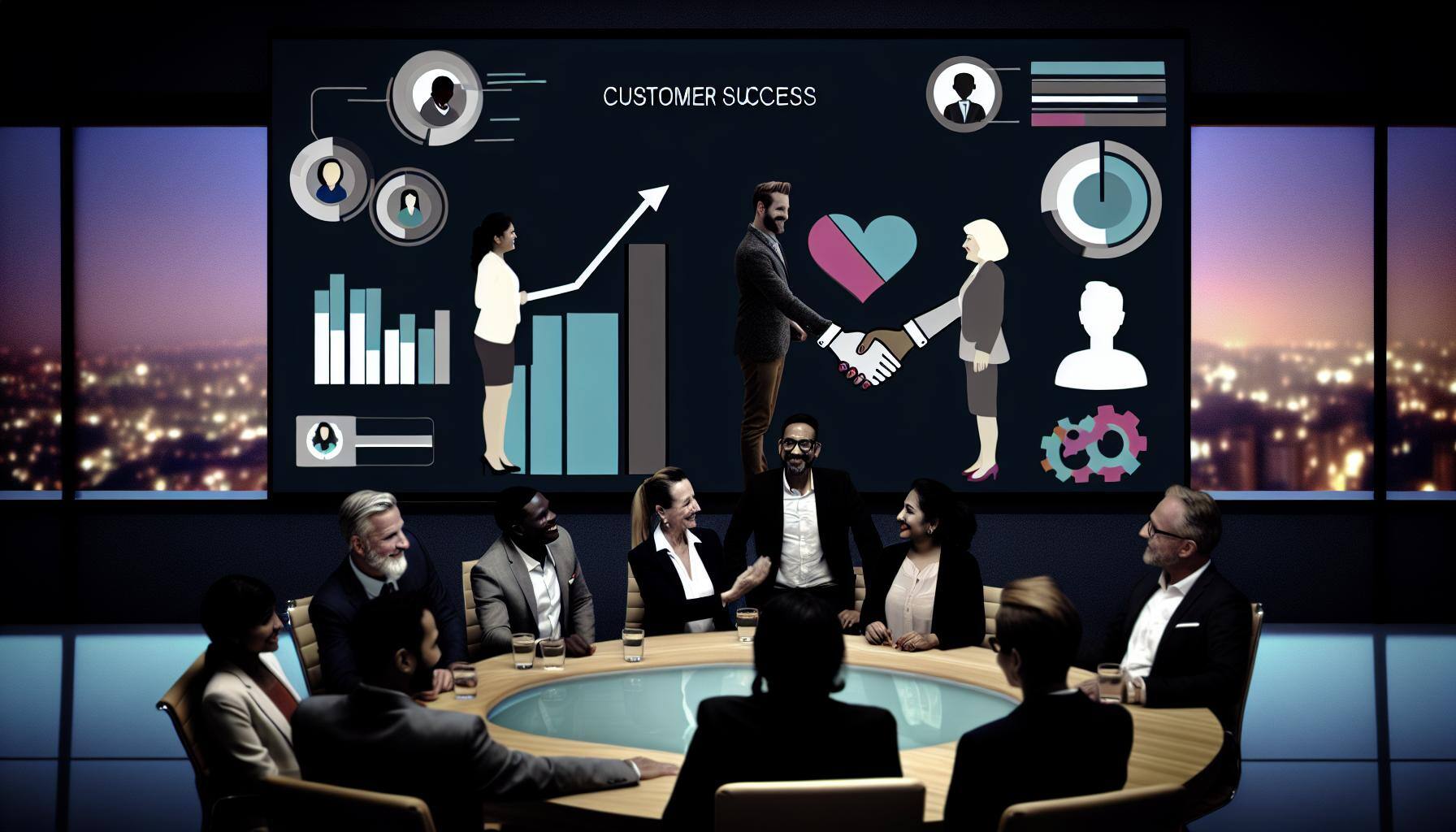Customer Churn Strategy to the C-Suite Level
How You, as a C-Level Executive, Can Reduce Churn in Key Accounts In this guide, we will explore the significant role you play in reducing churn in...
5 min read
Brian Polackoff
:
Feb 16, 2024 3:46:00 PM

Customer experience is the heartbeat of successful SaaS businesses. By focusing on elevating the user journey, you foster loyalty, reduce churn, and ultimately drive growth. Here are eight practical strategies that can help your company stand out and keep customers coming back.
And if these sound daunting—don’t worry. It’s all about taking one step at a time, and before you know it, you’ll be building the kind of customer loyalty that has people talking. After all, who doesn’t want customers so happy they write love letters to your support team?
Have you tried any of these , or do you have your own secret sauce for keeping customers happy? Let’s hear it!
Imagine signing up for a new software and immediately feeling like it was designed just for you. Kind of like when you walk into a coffee shop and they already know your favorite order—except this time, it's your software giving you that same 'I belong here' vibe. Personalizing the onboarding process makes this a reality, ensuring customers quickly realize the value of your SaaS application.
Action Plan:
Understand Customer Goals: Collect information on customer objectives during signup.
Customized Onboarding Paths: Develop multiple onboarding flows based on customer segments (Master SaaS Onboarding to Reduce Customer Churn).
Assign Dedicated Success Managers: Provide a point of contact for personalized assistance.
Follow-Up Communication: Send targeted emails or messages to guide users through key features.
Why It Works: Personalization accelerates user adoption and satisfaction, reducing churn rates and fostering loyalty. When customers feel supported from the very first interaction, they are more likely to engage deeply with your product.
To ensure customers achieve their desired outcomes, establishing a dedicated Customer Success Team can be a game-changer. If you can't dedicate staff to this, at least portion out the responsibility to existing folks at your company so someone will be accountable. This function will focus on helping customers succeed and grow. Think of it like having your own personal cheer squad, except instead of pom-poms, they come armed with solutions, support, and the occasional pep talk to keep customers on track!
Action Plan:
Define Roles and Responsibilities: Outline the scope of the customer success team (How to Build a High-Performing SaaS Customer Success Team).
Hire Experienced Professionals: Bring in team members with a background in customer relations.
Develop Success Plans: Create strategic plans for customer growth and retention.
Measure Key Metrics: Track customer health, usage, and satisfaction scores.
Why It Works: A proactive success team addresses customer needs, drives retention, and opens upselling opportunities. Imagine having someone guide you toward achieving more value—customers appreciate that.
Don’t wait for customers to come to you with problems—anticipate them. Proactive customer support helps solve issues before they escalate. It's like being that friend who knows you're about to run out of gas before you do and shows up with a full can—customers will appreciate you saving them from trouble before they even realize it's there!
Action Plan:
Implement Monitoring Tools: Use analytics to track user behavior.
Set Up Alerts: Identify triggers that indicate potential problems (How to Track Churn Metrics to Boost SaaS Retention).
Reach Out Early: Contact customers showing signs of disengagement.
Offer Solutions: Provide resources or assistance to address issues.
Why It Works: Proactive support prevents problems from escalating, improving satisfaction and loyalty. It makes customers feel valued, knowing you’re looking out for them.
Understanding customer health is like having a pulse on your business relationships. A health score system allows you to predict and prevent customer churn. It's kind of like being a fortune teller for your customers—except instead of a crystal ball, you have data, and instead of predicting their love life, you're predicting (and preventing) their departure!
Action Plan:
Define Health Metrics: Determine which factors indicate customer success (e.g., login frequency, feature usage).
Create a Scoring Model: Assign weights to each metric to calculate a health score (Reduce Churn with Customer Health Scores).
Regularly Review Scores: Schedule periodic assessments of customer health.
Intervene When Necessary: Reach out to at-risk customers with support.
Why It Works: Identifying at-risk customers allows for timely action to prevent churn. If you don't want to DIY this, and perhaps given it's importance, you shouldn't, take a look at Churn Assassin - an early warning siren that helps retain customers before it's too late.
Your customers are a treasure trove of insights. Establishing regular feedback loops helps you understand their needs and make improvements accordingly. Think of it like those suggestion boxes you see in restaurants—except instead of a crumpled napkin saying 'more ketchup,' you're getting actionable insights to make your product even better! You may think you don't have time for this, but you also don't have time to lose money.
Action Plan:
Surveys and Questionnaires: Deploy regular NPS surveys and feedback forms (Leverage Customer Feedback to Continuously Improve Your SaaS).
Feedback Channels: Provide easy ways for customers to share thoughts (e.g., in-app chat, email).
Analyze Feedback: Categorize and prioritize feedback for action.
Communicate Changes: Inform customers about updates made based on their input.
Why It Works: Showing customers that their opinions matter increases satisfaction and trust. Plus, actionable feedback helps you continuously improve your product.
In-app messaging provides help exactly when users need it, without them having to leave the platform. This is especially effective in guiding new users or introducing new features. Kind of like when you're lost in a massive IKEA, except instead of a friendly arrow on the floor pointing you to the exit, your software actually tells you how to find what you need—without the frustration of assembling furniture!
Action Plan:
Implement Tooltips and Guides: Highlight features and provide usage tips.
In-App Chat Support: Allow users to contact support without leaving the app.
Personalized Messages: Send messages based on user behavior.
Update Content Regularly: Keep guidance relevant with new features (Unlock Growth with Proven Customer Retention Tools).
Why It Works: It enhances user experience by providing help when and where it’s needed, reducing frustration and ensuring users feel confident in using the app.
Not all customers are the same—segmenting them allows you to provide better experiences that cater specifically to their characteristics. It’s like being the DJ at a party with wildly different groups—grandparents, teenagers, and your weird uncle who only likes polka. You’re not going to play the same song for everyone, right? They'd throw you out the door, and with good reason. Segmenting helps you hit the right notes with each audience!
Action Plan:
Identify Key Segments: Group customers based on industry, size, usage patterns, etc. (How Customer Segmentation Can Drive SaaS Growth in 2024).
Customize Communications: Develop messaging and content for each segment.
Adapt Services: Offer features or support levels tailored to each group.
Monitor Segment Performance: Track metrics to assess the effectiveness of segmentation.
Why It Works: Tailored experiences increase relevance and engagement, leading to higher retention rates. It’s like receiving a personalized experience rather than a one-size-fits-all approach—customers notice and appreciate that.
I know, I know. You are already doing this right? We often see, especially in early/mid stage products, the training and educational resources aren't designed for the true beginner. They expect the reader to already be familiar with the concepts of the solution. As you grow, and capture more of the market, you have to assume less. Providing high quality entry-level resources helps new customers make the most out of your product. Kind of like that one high school teacher who gave you all the notes you needed before the exam—except this time, there's no pop quiz, just a smoother experience with your product.
Action Plan:
Create Knowledge Bases: Develop comprehensive guides and FAQs (The Ultimate Guide to SaaS Customer Education for Success).
Webinars and Workshops: Host live sessions on advanced features or best practices.
Certification Programs: Offer courses that certify proficiency in your product.
Regular Updates: Keep educational content current with product changes.
Why It Works: Empowered customers are more likely to fully adopt the product and less likely to churn. When they know how to use the product effectively, they’ll derive more value and stick around longer.
Improving customer experience is a necessity for driving growth and reducing churn. By implementing these eight strategies, you’ll be able to build stronger relationships with your customers, keep them satisfied, and grow your business sustainably.
Now since you just learned all this fantastic knowledge from us, you probably have accounts that might churn unless you do something. We can give you a 3 to 6 month heads-up on which accounts those are. Want to try a free trial of Churn Assassin and keep more of your customers?

How You, as a C-Level Executive, Can Reduce Churn in Key Accounts In this guide, we will explore the significant role you play in reducing churn in...

In the fast-paced world of B2B SaaS, keeping your customers is the difference between thriving and merely surviving. High churn rates can drain your...

In the world of SaaS companies, keeping your customers from leaving is super important. When customers leave, it directly impacts your business's...